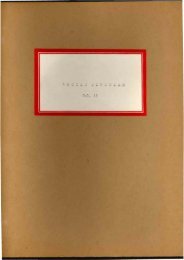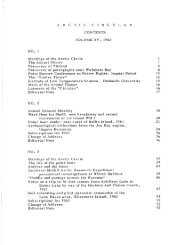Volume 4, 1951 - The Arctic Circle - Home
Volume 4, 1951 - The Arctic Circle - Home
Volume 4, 1951 - The Arctic Circle - Home
Create successful ePaper yourself
Turn your PDF publications into a flip-book with our unique Google optimized e-Paper software.
Burwell. This was found to be partly elear of iee, and<br />
soundings showed that it afforded a reasonable anehorage<br />
for the Algerine. By noon the ship was lying at anehor in<br />
Fox Harbour, and that afternoon a base line was measured<br />
over the ice. It VJas believed that the nineteen-foot tide<br />
range eaused too mueh discrepaney in the measurements.<br />
However, a subsequent subtense base measurement cheeked<br />
with the iee measurements within three tenths of a foot.<br />
Triangulation was begun, the lumber to build the triangulation<br />
stations being earried over the iee.<br />
<strong>The</strong> weather for the next few days was eomparatively<br />
warm and sunny, and was, in faet, the most pleasant weather<br />
during the whole season. <strong>The</strong>· sun, eombined vJith the effeet<br />
of spring tides, weakened the iee in the harbour. On July 3<br />
the ship sailed from Fox Harbour to begin breaking out the<br />
ice in Port Burwell. Captain Haneoek handled the ship with<br />
great skill, and large pans of iee were broken out and pushed<br />
pieeemeal into Forbes Sound, where the rapid tide stream and<br />
favourable winds carI'ied them into Hudson Strait. That same<br />
evening, the Algerine was at anchor in Port Burwell, now eompletely<br />
free of iee. <strong>The</strong> following four days the weather<br />
continued favourable and 24 triangulation stations were built,<br />
the subtense base measurement was completed, and observing<br />
done. However, the weather turned, and on July 9, when ready<br />
to begin sounding, strong westerly winds brought large pans<br />
of iee back, and all boats had to be hoisted. On July 11<br />
both launehes were again out sounding, running between the<br />
iee pans and hampered, in addition, by a considerable swell.<br />
From July 17 to 20, operations were once more brought to a<br />
near standstill by fog followed by a southeast gale. During<br />
this tliae, the Hydrographie Survey ship Terra Nova, Mr. Goodwill<br />
in charge, .sought shel ter in the harbour, while on passage to<br />
Southampton Island. On July 21 both launehes eompleted final<br />
soundings in Forbes Sound, again eontending with heavy iee and<br />
choppy seas. Rock posts were established, the tide gauge d:smantled,<br />
and final sun observations for azimuth completed.<br />
Continuous iee reports relayed from the air base ac<br />
Koojesse Inlet, Frobisher Bay, through the Department of Transport<br />
radio station at.Resolution Island, had so far indicaJed<br />
that the Frobisher Bay ieewas unbroken and impassable. 0:<br />
July 21 the iee was reported to be moving out of the bay, tnd<br />
no time was lost in eompleting all that was possible at Pœt<br />
Burwell. <strong>The</strong> Algerine proeeeded on passage to Frobisher ai<br />
1815 on July 21. Twenty-three days had been spent in the<br />
Port Burwell area, but on only nine of these had a full da"s<br />
work been possible.












